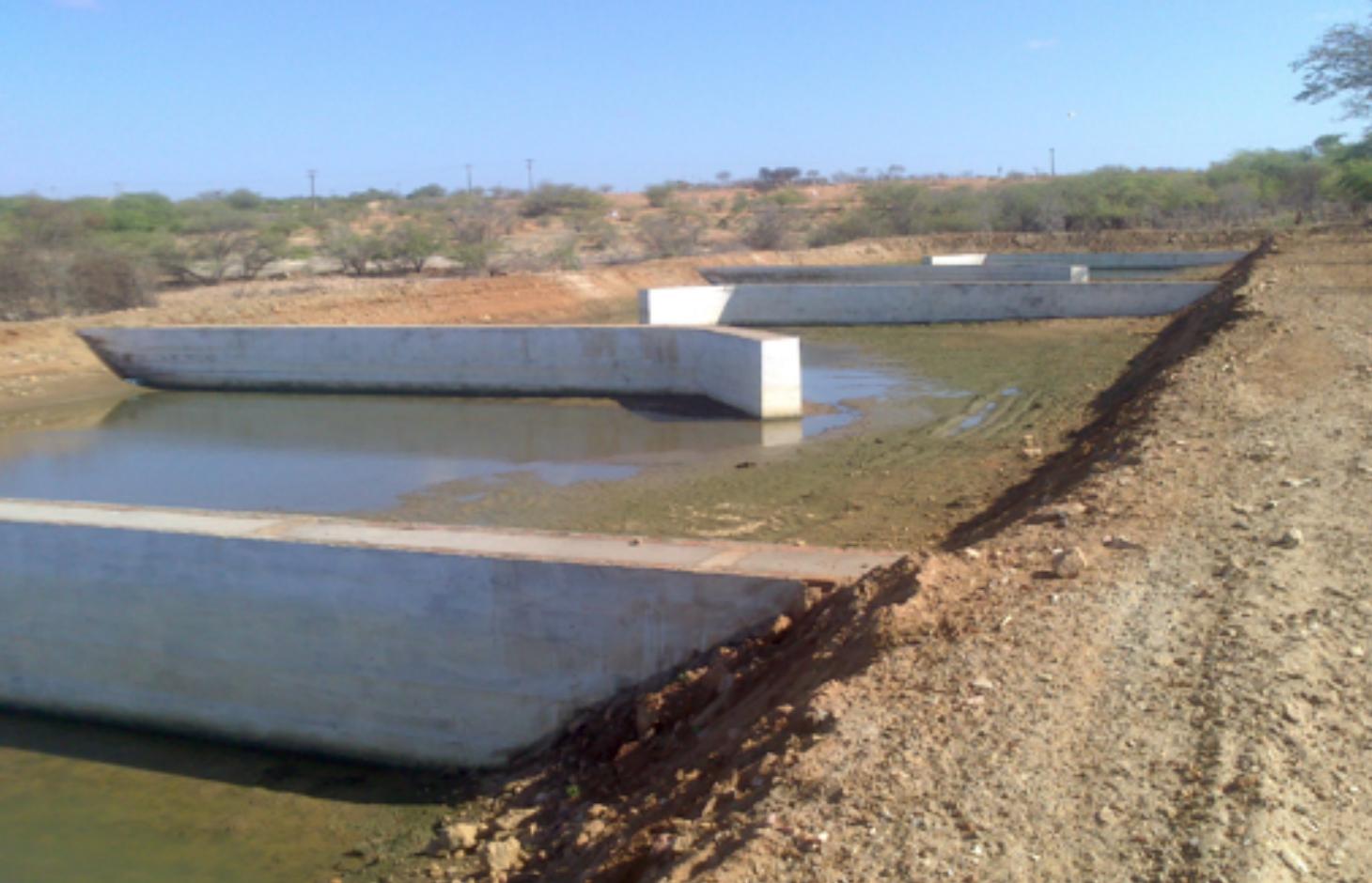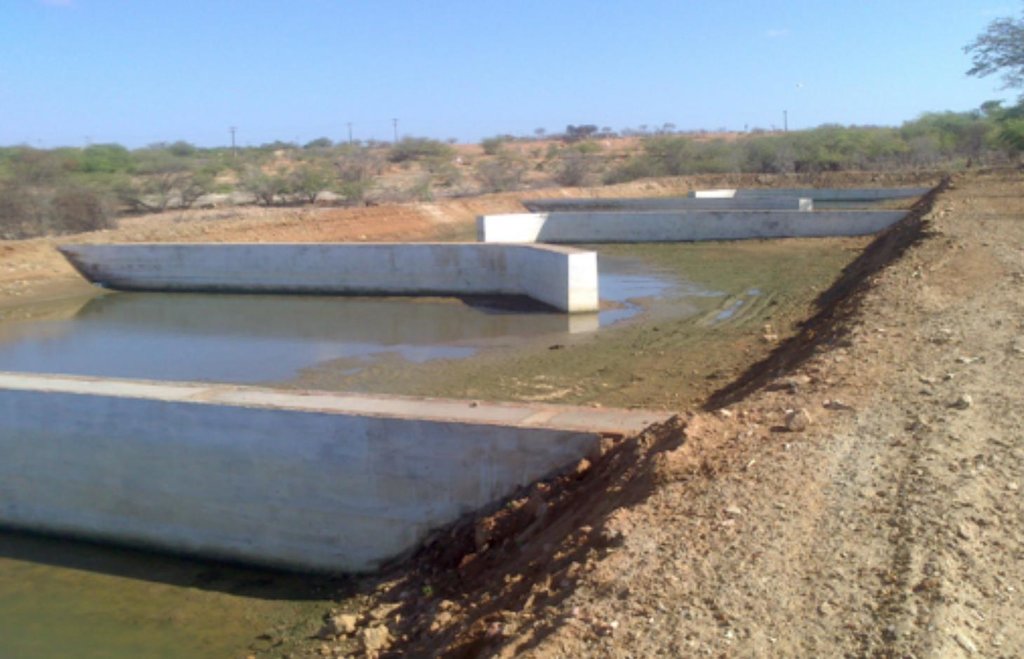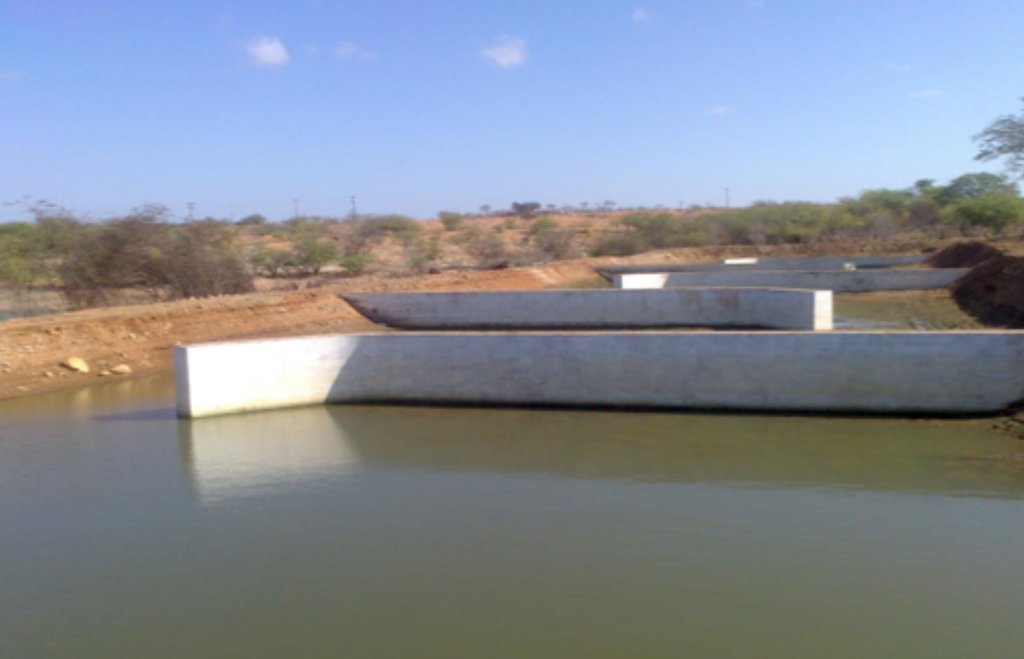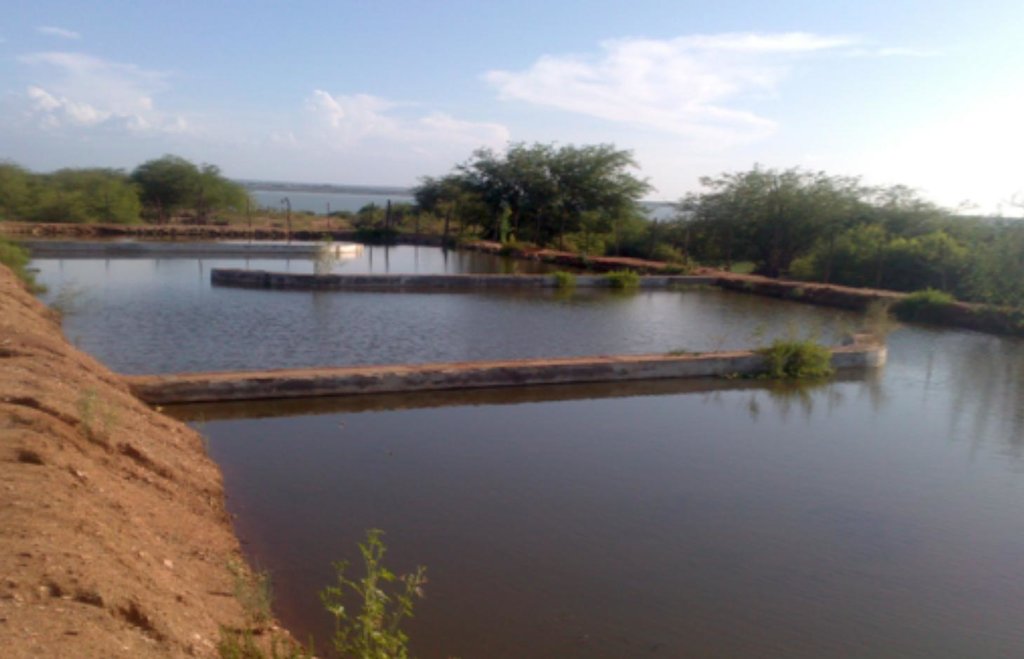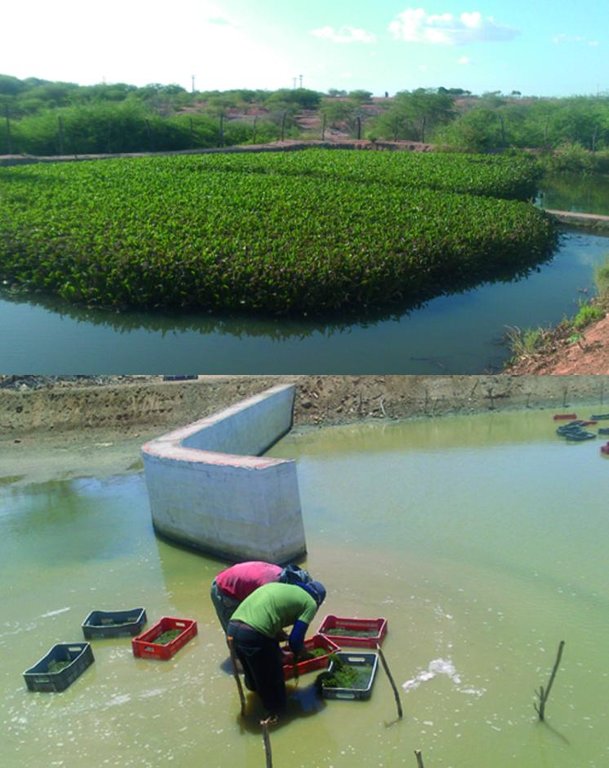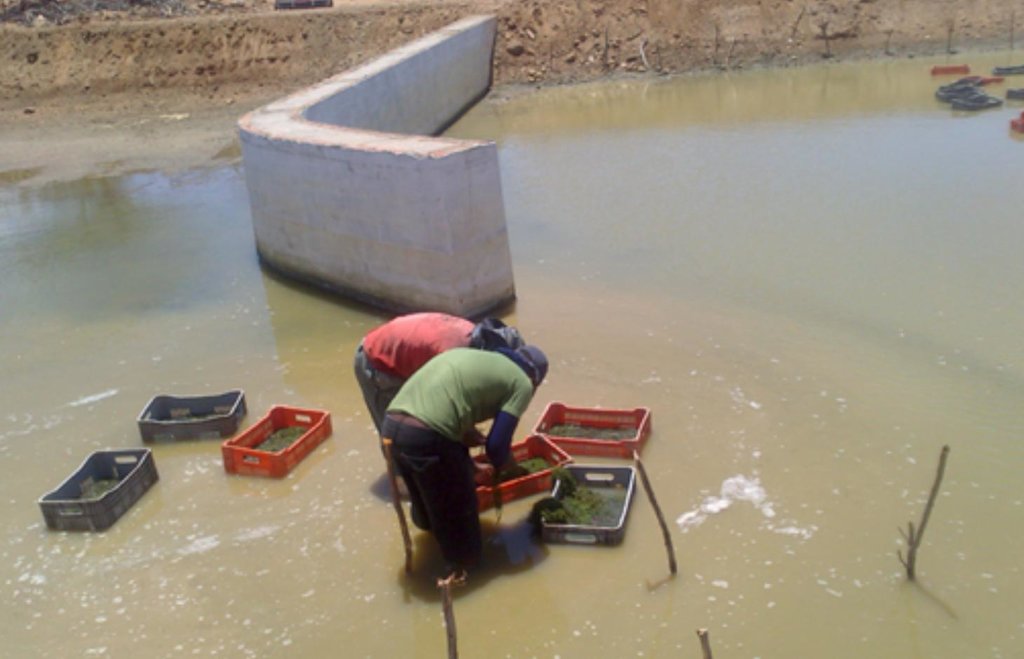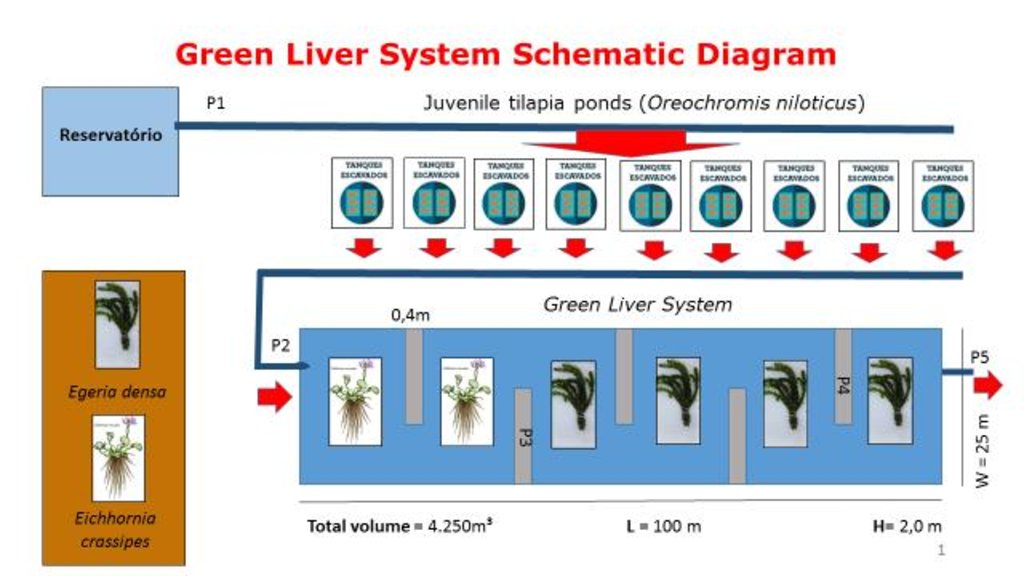The “Green Liver System”: eco-friendly water purification [Brésil]
- Création :
- Mise à jour :
- Compilateur : Marianna Siegmund-Schultze
- Rédacteur : –
- Examinateur : Fabian Ottiger
Fitorremediação (Portuguese)
technologies_1710 - Brésil
- Résumé complet en PDF
- Résumé complet en PDF pour impression
- Résumé complet dans le navigateur
- Résumé complet (non formaté)
- The “Green Liver System”: eco-friendly water purification : 7 mars 2019 (public)
- The “Green Liver System”: eco-friendly water purification : 29 avril 2017 (inactive)
- The “Green Liver System”: eco-friendly water purification : 20 mars 2017 (inactive)
- The “Green Liver System”: eco-friendly water purification: 8 mars 2017 (inactive)
- The “Green Liver System”: eco-friendly water purification: 7 mars 2017 (inactive)
Voir les sections
Développer tout Réduire tout1. Informations générales
1.2 Coordonnées des personnes-ressources et des institutions impliquées dans l'évaluation et la documentation de la Technologie
Spécialiste GDT:
Spécialiste GDT:
Nom du projet qui a facilité la documentation/ l'évaluation de la Technologie (si pertinent)
Book project: Making sense of research for sustainable land management (GLUES)Nom du ou des institutions qui ont facilité la documentation/ l'évaluation de la Technologie (si pertinent)
Leibniz-Institut für Gewässerökologie und Binnenfischerei (IGB) - AllemagneNom du ou des institutions qui ont facilité la documentation/ l'évaluation de la Technologie (si pertinent)
Potsdam-Institut für Klimaforschung (PIK) - AllemagneNom du ou des institutions qui ont facilité la documentation/ l'évaluation de la Technologie (si pertinent)
Universität Hohenheim - AllemagneNom du ou des institutions qui ont facilité la documentation/ l'évaluation de la Technologie (si pertinent)
Technische Universität Berlin (Technische Universität Berlin) - AllemagneNom du ou des institutions qui ont facilité la documentation/ l'évaluation de la Technologie (si pertinent)
Hochschule für Technik und Wirtschaft Dresden (HTW Dresden) - Allemagne1.3 Conditions relatives à l'utilisation par WOCAT des données documentées
Le compilateur et la(les) personne(s) ressource(s) acceptent les conditions relatives à l'utilisation par WOCAT des données documentées:
Oui
2. Description de la Technologie de GDT
2.1 Courte description de la Technologie
Définition de la Technologie:
Water purification using macrophytes to treat effluent from fish farming.
2.2 Description détaillée de la Technologie
Description:
The “Green Liver System” uses aquatic plants, established in artificial wetlands, to remove, transfer, stabilize or eliminate pollutants in wastewater from fish farms. The use of large quantities of feed in aquaculture, along with the application of antibiotics, hormones and probiotics, has negative impacts on aquatic ecosystems due to the introduction of nitrogen, phosphorous and drug residues into the system. The Green Liver System is a form of phytoremediation (phyto = plant and remediate = correct) that uses a range of plants to decompose, extract, or hold contaminants present in soils and waters. This technology has been considered as an innovative alternative and a low cost option compared to others used in contaminated sites - like membrane bioreactors, upflow anaerobic sludge blanket (UASB), and others.
Purpose of the Technology: The plants selected for use in Green Liver System artificial wetlands depend on the pollutant to be removed. Research shows physiological differences between species, which need to be taken into account when planning wastewater treatments. Ideal plants for phytoremediation need: a) a fast growth rate; b) high biomass production; c) long rooting systems; d) easy maintenance/pruning; e) to be able to persists, and f) to have the ability to store trace metals within specific parts which can be later removed.
Establishment / maintenance activities and inputs: The Green Liver System uses aquatic macrophytes, which extract contaminants from the water, store them, or even metabolize them - transforming them into less toxic or harmless products. In the case of Eichhornia crassipes, most of the solids in suspension are removed by sedimentation or by adsorption in the root system. The dense coverage of these plants reduces the mixing effect of the wind, as well as minimizing thermal mixture. Shading by the plants restricts algal growth and the root system prevents horizontal movement of particulate material. In this way, particles are removed from the wastewater and microorganisms associated with the plants’ rhizosphere slowly decompose. Many organisms can be used in biodegradation: these include bacteria and fungi as well as plants, and the efficiency of one or the other depend, in many cases, on the molecule structure and of the presence of enzymes that are effective in degrading the pollutant.
Natural / human environment: The fish farm used as an example here is located on the margins of the Itaparica reservoir in Brazil. There are dozens of excavated tanks used to produce tilapia (Oreochromis niloticus) and “tambaqui” (Colossoma macropomum) fingerlings and juvenile fish. As well as these tanks, there are many net enclosures installed in the reservoir where the fishes are reared to maturity. Part of the wastewater from the excavated tanks is released into a stabilization lagoon, and the remainder goes to the Green Liver System. The effluent is enriched with spare feed, and excreta from the fish, which includes drug residues. If not treated, this may cause eutrophication because of its mineral richness. The Green Liver System consists of an excavated tank of 100m x 20m x 2m in size. The tank is subdivided into six parts: two planted to Eichhornia crassipes and four to Egeria densa. A mesh barrier stops fish from being flushed into the tank. Regular monitoring of the physical, chemical and biological parameters is required to control environmental fluctuations.
2.3 Photos de la Technologie
2.5 Pays/ région/ lieux où la Technologie a été appliquée et qui sont couverts par cette évaluation
Pays:
Brésil
Région/ Etat/ Province:
Pernambuco
Autres spécifications du lieu:
Vila do Coité, Itacuruba
Map
×2.6 Date de mise en œuvre de la Technologie
Si l'année précise est inconnue, indiquez la date approximative: :
- il y a moins de 10 ans (récemment)
2.7 Introduction de la Technologie
Spécifiez comment la Technologie a été introduite: :
- au cours d'expérimentations / de recherches
Commentaires (type de projet, etc.) :
Construction took place in 2013, building on earlier experiences of the principal scientist, for instance in South Korea.
3. Classification de la Technologie de GDT
3.2 Type(s) actuel(s) d'utilisation des terres, là où la Technologie est appliquée

Voies d'eau, plans d'eau, zones humides
Commentaires:
Major land use problems (compiler’s opinion): The Itaparica reservoir was completed in 1988 to generate hydropower. About 40,000 people were compulsorily relocated. The construction of the reservoir had interrupted fish movement, leading to a shortage of fish, making aquaculture a viable and profitable alternative, and current law allows this. However excess feed and excreta of fish, partly containing drug residues, add nutrients and pollute water. ECONOMIC ASPECTS: The agricultural economy of this semi-arid region is characterized by pastoral activities, as well as the cultivation of crop species resistant to drought, such as cotton, corn (maize), beans, and cassava in humid areas. Irrigation from the reservoir was potentially possible but investments in aquaculture proved more profitable. In general, the commercial companies involved do not treat effluent, leading to pollution. Even though monitoring is mandatory, almost nobody does it, nor do they make substantial efforts to purify the effluent.
Major land use problems (land users’ perception): There are several conflicts over water and related land use in the region. Some people say the water quality in the reservoir is good (and use it directly for drinking), others report ill-health especially during times of low water levels. Commercial aquaculture primarily produces tilapia. Invariably, some tilapia escape from their net cages and take over from other local species. The hydroelectric company manages the reservoir according to national needs in electricity – thus sudden water level fluctuations are frequent. Commercial aquaculture and associated land use dominate the shoreline, preventing access for artisanal fishermen to their traditional fishing grounds.
Future (final) land use (after implementation of SLM Technology): Other: Ow: Waterways, drainage lines, ponds, dams
Constraints of transition land, fallow or sporadicall used by roaming livestock (mainly goats) (area in between the land-based aquaculture and the lake)
Si l'utilisation des terres a changé en raison de la mise en œuvre de la Technologie, indiquez l'utilisation des terres avant la mise en œuvre de la Technologie:
Grazing land: Ge: Extensive grazing land
3.3 Informations complémentaires sur l'utilisation des terres
Approvisionnement en eau des terres sur lesquelles est appliquée la Technologie:
- mixte: pluvial-irrigué
Nombre de période de croissance par an: :
- 1
Précisez:
Longest growing period from month to month: all year due to tropical climate
3.4 Groupe de GDT auquel appartient la Technologie
- gestion des eaux de surface (sources, rivières, lacs, mers)
- gestion/ protection des zones humides
- Water purification
3.5 Diffusion de la Technologie
Commentaires:
Total area covered by the SLM Technology is 2 m2.
The reservoir is 100m long and 20 m wide, with a depth of 1.7 m, but the area may be larger depending on the volume of effluent to be treated. The whole area comprises the fish ponds.
3.6 Mesures de GDT constituant la Technologie

pratiques végétales
- V5: Autres

structures physiques
- S5: Barrages/retenues, micro-bassins, étangs
Commentaires:
Main measures: vegetative measures
Secondary measures: structural measures
Specification of other vegetative measures: macrophytes, different species
Type of vegetative measures: in blocks
3.7 Principaux types de dégradation des terres traités par la Technologie

dégradation hydrique
- Hp: baisse de la qualité des eaux de surface
Commentaires:
Main type of degradation addressed: Hp: decline of surface water quality
Main causes of degradation: deforestation / removal of natural vegetation (incl. forest fires) (slash-and-burn practices), over-exploitation of vegetation for domestic use (firewood and charcoal making), overgrazing (free roaming run-wild donkeys, and small ruminants), urbanisation and infrastructure development (construction works near to body bodies (not respecting conservation areas)), discharges (point contamination of water) (indiscriminate disposal of effluents; excrements, drugs and surplus feed from fishes in net-cages), over abstraction / excessive withdrawal of water (for irrigation, industry, etc.) (abstraction of water from the reservoir without prior registration, not holding water use permits), change in temperature (supposed to be climate change induced), change of seasonal rainfall (high variability in semi-arid regions rather normal; though rainfall appears to fall in shorter periods), droughts (recurrent droughts are "normal", they appear to last for longer periods), poverty / wealth (limited livelihood sources in the rather remote municipality), inputs and infrastructure: (roads, markets, distribution of water points, other, …) (spoilage and low quality), education, access to knowledge and support services (often little value attached to natural resources), war and conflicts (conflicts among two families; conflicts among indigenous and commercial users), governance / institutional (restricted enforcement of existing rules; clientelism)
Secondary causes of degradation: soil management, crop management (annual, perennial, tree/shrub), industrial activities and mining, release of airborne pollutants (urban/industry…), disturbance of water cycle (infiltration / runoff), Heavy / extreme rainfall (intensity/amounts), wind storms / dust storms, floods, other natural causes (avalanches, volcanic eruptions, mud flows, highly susceptible natural resources, extreme topography, etc.) specify, population pressure, land tenure, labour availability
3.8 Prévention, réduction de la dégradation ou réhabilitation des terres dégradées
Spécifiez l'objectif de la Technologie au regard de la dégradation des terres:
- réduire la dégradation des terres
Commentaires:
Main goals: mitigation / reduction of land degradation
4. Spécifications techniques, activités, intrants et coûts de mise en œuvre
4.1 Dessin technique de la Technologie
Auteur:
Stephan Pflugmacher-Lima, TUB, Faculty VI Planning Building Environment; Sekr. A1; Str des 17. Juni 152; 10623 Berlin; Germany
4.2 Spécification/ explications techniques du dessin technique
The constructed wetland termed a “Green Liver System” is 100m x 25m x 2.0m in size. It is divided into six parts (one third of the tank planted with Eichhornia crassipes the remainder with Egeria densa). The average outflow during the period was 1,800 m³/h. Point P1 is the catchment from the reservoir. Point P2 is the inlet that receives the discharge of effluent from 10 ponds with juvenile tilapia (Oreochromis niloticus). Point P3 is the stage after the treatment with Eichhornia crassipes. Point P4 is the stage of the treatment with Egeria densa. Point P5 is the outlet into a containment basin.
Location: Itacuruba. Pernambuco
Date: 2013
Technical knowledge required for field staff / advisors: high (It is a sophisticated system which requires close observation and monitoring. Site-specific adaptation might be necessary (for instance fencing to avoid goats entering the area).)
Technical knowledge required for land users: high (It is a sophisticated system which requires close observation and monitoring. It will be easier with some experience.)
Main technical functions: improvement of water quality, buffering / filtering water
In blocks
Vegetative material: O : other
Number of plants per (ha): 250000
Other species: Egeria densa; Eichhornia crassipes
Dam/ pan/ pond
Depth of ditches/pits/dams (m): 1.7
Width of ditches/pits/dams (m): 20
Length of ditches/pits/dams (m): 100
Wall/ barrier
Depth of ditches/pits/dams (m): 1.7
Width of ditches/pits/dams (m): ca 0.3
Length of ditches/pits/dams (m): ca 15
Construction material (other): tubes, valves
Specification of dams/ pans/ ponds: Capacity 3400m3
Dimensions of spillways: ca 100m
4.3 Informations générales sur le calcul des intrants et des coûts
Indiquez la monnaie utilisée pour le calcul des coûts:
- dollars US
Indiquer le taux de change du dollars en monnaie locale (si pertinent): 1 USD= :
3,17
Indiquez le coût salarial moyen de la main d'œuvre par jour:
25.00
4.4 Activités de mise en place/ d'établissement
| Activité | Type de mesures | Calendrier | |
|---|---|---|---|
| 1. | Digging the pit, stabilizing the walls | Végétale | |
| 2. | Fencing | Végétale | |
| 3. | Building separation walls | Végétale | |
| 4. | Planting macrophytes in place | Végétale |
4.5 Coûts et intrants nécessaires à la mise en place
| Spécifiez les intrants | Unité | Quantité | Coûts par unité | Coût total par intrant | % des coût supporté par les exploitants des terres | |
|---|---|---|---|---|---|---|
| Main d'œuvre | Construction | 1,0 | 3000,0 | 3000,0 | ||
| Main d'œuvre | Macrophyte installation | 1,0 | 1900,0 | 1900,0 | ||
| Equipements | Truck for removal of soil | 1,0 | 125,0 | 125,0 | ||
| Matériel végétal | Macrophytes | 100,0 | ||||
| Matériel végétal | Wooden fence posts | 100,0 | ||||
| Matériaux de construction | Walls/baffles (cement) | 1,0 | 475,0 | 475,0 | ||
| Matériaux de construction | Barbed wire | 1,0 | 315,0 | 315,0 | ||
| Matériaux de construction | Earthwork | 1,0 | 250,0 | 250,0 | ||
| Matériaux de construction | Tubular elements | 1,0 | 30,0 | 30,0 | ||
| Autre | Labour: Cutting fence posts | 1,0 | 160,0 | 160,0 | ||
| Autre | Labour: SUpervision | 1,0 | 1000,0 | 1000,0 | ||
| Coût total de mise en place de la Technologie | 7255,0 | |||||
4.6 Activités d'entretien/ récurrentes
| Activité | Type de mesures | Calendrier/ fréquence | |
|---|---|---|---|
| 1. | Exchange macrophytes | Végétale |
4.7 Coûts et intrants nécessaires aux activités d'entretien/ récurrentes (par an)
| Spécifiez les intrants | Unité | Quantité | Coûts par unité | Coût total par intrant | % des coût supporté par les exploitants des terres | |
|---|---|---|---|---|---|---|
| Main d'œuvre | Labour | 1,0 | 3000,0 | 3000,0 | ||
| Equipements | Nylon fabric | 1,0 | 15,0 | 15,0 | ||
| Matériel végétal | Macrophytes | 1,0 | 100,0 | |||
| Coût total d'entretien de la Technologie | 3015,0 | |||||
Commentaires:
Because of the tropical climate of Brazilian northeast there is a need to remove Eichhornia crassipes periodically because it grows very quickly as there is plenty nutrients and warm temperatures during all year. The cost of removal of the macrophytes is permanent and must be made monthly as the plant reaches adulthood it loses its capability in removing nutrients and gives it back to the water.
5. Environnement naturel et humain
5.1 Climat
Précipitations annuelles
- < 250 mm
- 251-500 mm
- 501-750 mm
- 751-1000 mm
- 1001-1500 mm
- 1501-2000 mm
- 2001-3000 mm
- 3001-4000 mm
- > 4000 mm
Spécifications/ commentaires sur les précipitations:
It happened to be less than 100mm in 2013. Very unreliable rainfall pattern. Rainfall from Dezember to May, most rain often in March
Zone agro-climatique
- semi-aride
Thermal climate class: tropics. Bsh according to Köppen classification
5.2 Topographie
Pentes moyennes:
- plat (0-2 %)
- faible (3-5%)
- modéré (6-10%)
- onduleux (11-15%)
- vallonné (16-30%)
- raide (31-60%)
- très raide (>60%)
Reliefs:
- plateaux/ plaines
- crêtes
- flancs/ pentes de montagne
- flancs/ pentes de colline
- piémonts/ glacis (bas de pente)
- fonds de vallée/bas-fonds
Zones altitudinales:
- 0-100 m
- 101-500 m
- 501-1000 m
- 1001-1500 m
- 1501-2000 m
- 2001-2500 m
- 2501-3000 m
- 3001-4000 m
- > 4000 m
5.3 Sols
Profondeur moyenne du sol:
- très superficiel (0-20 cm)
- superficiel (21-50 cm)
- modérément profond (51-80 cm)
- profond (81-120 cm)
- très profond (>120 cm)
Texture du sol (de la couche arable):
- moyen (limoneux)
Matière organique de la couche arable:
- faible (<1%)
Si disponible, joignez une description complète du sol ou précisez les informations disponibles, par ex., type de sol, pH/ acidité du sol, capacité d'échange cationique, azote, salinité, etc.
Soil fertility is low
Soil drainage/infiltration is poor
Soil water storage capacity is very low
5.4 Disponibilité et qualité de l'eau
Profondeur estimée de l’eau dans le sol:
< 5 m
Disponibilité de l’eau de surface:
faible/ absente
Qualité de l’eau (non traitée):
faiblement potable (traitement nécessaire)
5.5 Biodiversité
Diversité des espèces:
- moyenne
5.6 Caractéristiques des exploitants des terres appliquant la Technologie
Revenus hors exploitation:
- > 50% de tous les revenus
Niveau relatif de richesse:
- moyen
- riche
Individus ou groupes:
- individu/ ménage
Genre:
- hommes
Indiquez toute autre caractéristique pertinente des exploitants des terres:
Land users applying the Technology are mainly common / average land users
Population density: < 10 persons/km2
Annual population growth: 1% - 2%
5.7 Superficie moyenne des terres détenues ou louées par les exploitants appliquant la Technologie
- < 0,5 ha
- 0,5-1 ha
- 1-2 ha
- 2-5 ha
- 5-15 ha
- 15-50 ha
- 50-100 ha
- 100-500 ha
- 500-1 000 ha
- 1 000-10 000 ha
- > 10 000 ha
Cette superficie est-elle considérée comme de petite, moyenne ou grande dimension (en se référant au contexte local)?
- petite dimension
5.8 Propriété foncière, droits d’utilisation des terres et de l'eau
Propriété foncière:
- individu, sans titre de propriété
- individu, avec titre de propriété
Droits d’utilisation des terres:
- individuel
- needs official registration and permission; heavy water use has a price
- needs official registration and permission; heavy water use has a price
5.9 Accès aux services et aux infrastructures
santé:
- pauvre
- modéré
- bonne
éducation:
- pauvre
- modéré
- bonne
assistance technique:
- pauvre
- modéré
- bonne
emploi (par ex. hors exploitation):
- pauvre
- modéré
- bonne
marchés:
- pauvre
- modéré
- bonne
énergie:
- pauvre
- modéré
- bonne
routes et transports:
- pauvre
- modéré
- bonne
eau potable et assainissement:
- pauvre
- modéré
- bonne
services financiers:
- pauvre
- modéré
- bonne
extension service:
- pauvre
- modéré
- bonne
6. Impacts et conclusions
6.1 Impacts sur site que la Technologie a montrés
Impacts socio-économiques
Disponibilité et qualité de l'eau
disponibilité de l'eau potable
disponibilité de l'eau pour l'élevage
disponibilité de l'eau d'irrigation
Revenus et coûts
diversité des sources de revenus
Commentaires/ spécifiez:
Biomass of macrophytes for potential ethanol production.
Autres impacts socio-économiques
Labour cost
Commentaires/ spécifiez:
Increase of maintenance costs as manual labor is required for management of macrophytes.
Impacts socioculturels
connaissances sur la GDT/ dégradation des terres
Commentaires/ spécifiez:
Better water management in a setting of decreasing seasonal rainfall.
Improved livelihoods and human well-being
Commentaires/ spécifiez:
The technology contributed to improved water quality, which is directly related to people's health.
Impacts écologiques
Cycle de l'eau/ ruissellement
qualité de l'eau
évaporation
Commentaires/ spécifiez:
Any open water body is subjected to the very high potential evaporation in the region. Though, the surface of the system is very small as compared to the adjacent reservoir.
Sols
couverture du sol
Commentaires/ spécifiez:
The vegetation had to be removed in order to construct the artificial wetland.
Autres impacts écologiques
Vulnerability
Commentaires/ spécifiez:
A nylon grid prevents the macrophytes from occasionally breaking loose into the reservoir.
The ecology of the system is sort of fragile. If the macrophytes float too much, the system can break down.
6.4 Analyse coûts-bénéfices
Quels sont les bénéfices comparativement aux coûts de mise en place (du point de vue des exploitants des terres)?
Rentabilité à court terme:
positive
Rentabilité à long terme:
positive
Quels sont les bénéfices comparativement aux coûts d'entretien récurrents (du point de vue des exploitants des terres)?
Rentabilité à court terme:
positive
Rentabilité à long terme:
positive
6.5 Adoption de la Technologie
Commentaires:
There is a little trend towards spontaneous adoption of the Technology
Comments on adoption trend: A broad adoption is not yet expectable at this stage of experimental analysis and testing. Few people did already express their interest.
6.7 Points forts/ avantages/ possibilités de la Technologie
| Points forts/ avantages/ possibilités du point de vue de l'exploitant des terres |
|---|
|
If the environmental authority increases controls of how effluent from aquaculture ponds is handled (checking pollution and nutrient loads in the effluent which is usually returned to the reservoir without any treatment), the technology would help compliance with existing rules. How can they be sustained / enhanced? Enhancing control and penalties would favour the adoption of such a green technology. Currently controls are rare or non-existent. |
|
The technology can be constructed using locally available material. How can they be sustained / enhanced? As long as cheap labour is available and rural shops exist, the availability of inputs is adequate. |
| Points forts/ avantages/ possibilités du point de vue du compilateur ou d'une autre personne ressource clé |
|---|
|
Water purification is realized by using natural processes. How can they be sustained / enhanced? If the related tilapia production unit could gain a green or ecological stamp, this would be beneficial and maybe trigger the adoption of the technology. |
|
Among the advantages of adopting the Green Liver technology are the low costs, the speed of construction and it's relatively easy operation. How can they be sustained / enhanced? Easily accessible and comprehensive information is needed, as well as the possibility to exchange experience among users or future users. |
6.8 Faiblesses/ inconvénients/ risques de la Technologie et moyens de les surmonter
| Faiblesses/ inconvénients/ risques du point de vue de l’exploitant des terres | Comment peuvent-ils être surmontés? |
|---|---|
| Additional manual labour increases costs (and hinders adoption) | The more people use such techniques, for instance due to improved environmental monitoring and fines imposed, the more such extra expenditure will be accepted as regular running costs. |
| The management of the system is not simple. Many different and unexpected disturbances can occur. Experience and close, constant watch out is needed. | Exchange of experience among users would facilitate its management. An updated list of threats could be helpful. |
| Faiblesses/ inconvénients/ risques du point de vue du compilateur ou d'une autre personne ressource clé | Comment peuvent-ils être surmontés? |
|---|---|
| From time to time the macrophytes have to be removed, tubes may need cleaning and the system needs to be set up again. Sometimes, the removal of almost all water may be indicated. Major maintenance can cause peak labour needs. Manual labour required to monitor the system on a regular basis, and perform maintenance according to needs. Depending on the number and size of Green Liver Systems in action, caring for them can be a full-time job. | The maintenance costs have to be well budgeted in the overall planning of costs and benefits of the related productive units. |
| The disposal of the removed macrophytes is still a problem to be solved. If the macrophytes have accumulated high levels of toxins, the biomass cannot be used for compost making or livestock feeding. | The removed macrophytes should be analysed for their pollutant content. A biodigester could be the solution to the disposal of contaminated biomass, generating energy for the productive unit and possibly for the local population too. |
7. Références et liens
7.2 Références des publications disponibles
Titre, auteur, année, ISBN:
Pflugmacher, S., Kühn, S., Lee, S.-H., Choi, J.-W., Baik, S., Kwon, K.-S., Contardo-Jara, V., 2015. Green Liver Systems® for water purification: Using the phytoremediation potential of aquatic macrophytes for the removal of different cyanobacterial toxins from water.
Disponible à partir d'où? Coût?
AJPS 06 (09), 1607–1618. doi:10.4236/ajps.2015.69161.
Titre, auteur, année, ISBN:
Nimptsch, J., Wiegand, C., Pflugmacher, S., 2008. Cyanobacterial toxin elimination via bioaccumulation of MC-LR in aquatic macrophytes: An application of the “Green Liver Concept”
Disponible à partir d'où? Coût?
Environ. Sci. Technol. 42 (22), 8552–8557. doi:10.1021/es8010404.
Liens et modules
Développer tout Réduire toutLiens
Aucun lien
Modules
Aucun module trouvé


